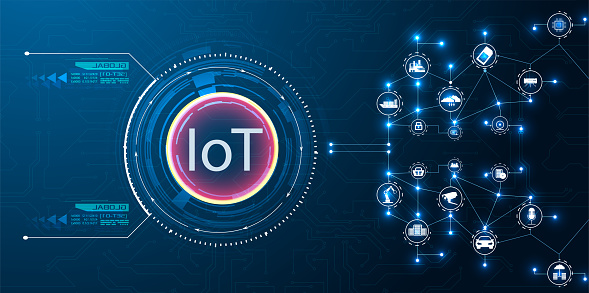Introduction
The spread of 5G commercially is not limited only to smartphones and will impact different world markets and industries as well as both wireless and wired network infrastructure. 5G will play a crucial role in many different business fields, including automotive, medical/healthcare, security, insurance, construction, distribution, industry, farming/forestry/fisheries, tourism, retail/services, entertainment (virtual reality (VR), augmented reality (AR) and mixed reality(MR)), public transport (rail and bus), public infrastructure (road and bridge monitoring), etc.
Most 5G use cases can be grouped under three main categories – enhanced mobile broadband (eMBB), massive IoT (Internet of Things), and critical communications, each with its own speed, capacity, and latency, requirements.
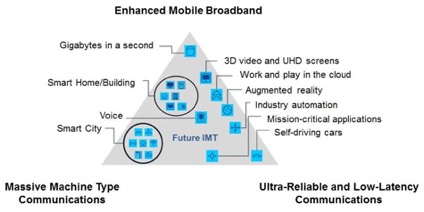
5G Use Cases (Source: 3GPP)
Although 4G will continue to be used for many consumer and enterprise IoT use cases, 5G provides a range of benefits to the IoT which are not available with 4G or other technologies. These include 5G’s ability to support a massive number of static and mobile IoT devices, which have a diverse range of speed, bandwidth, and quality of service requirements.
IoT in 5G Era
As the IoT evolves, the flexibility of 5G will become even more significant for enterprises seeking support for the strict requirements of critical communications. The ultra-reliability and low latency of 5G will allow self-driving cars, smart energy grids, enhanced factory automation, and other demanding applications to become a reality.
5G can meet the requirements of IoT devices, which have their own range of requirements and use cases. An IoT device can be anything from a low-power sensor, transmitting only small amounts of data intermittently, to a sophisticated edge device that relays real-time video to and from the cloud. 5G covers all of that.
There are two use cases/categories that can be addressed by 5G, Massive IoT/LPWA (mMTC) and Industrial IoT
(URLLC) as below:
- MASSIVE, MACHINE-TYPE COMMUNICATION (MMTC)
This is really the evolution of Low-Power Wide-Area (LPWA) LTE technologies for applications requiring a low-cost, low-current operation, with high coverage in high-density operating environments. 5G addresses this use-case with evolved versions of the two LPWA standards most widely used in the IoT today, LTE-M (which operates inside the LTE band) and NB-IoT (which operates at 200 kHz).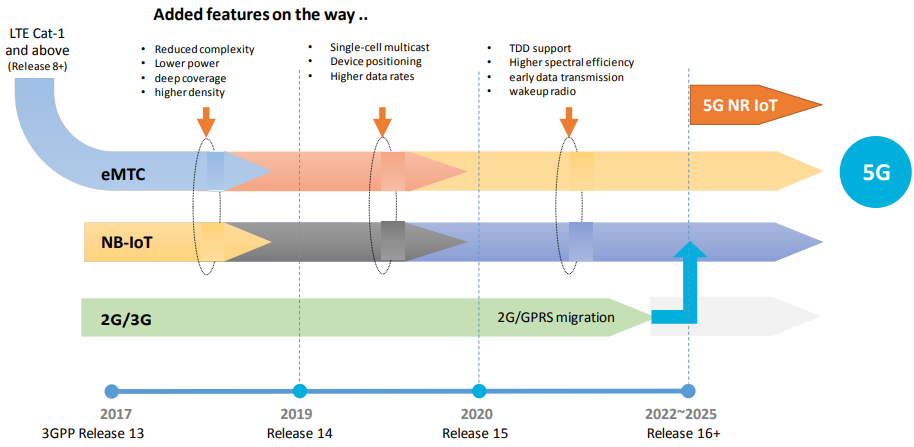
The Road to 5G (Source: SIERRA WIRELESS)
These technologies are designed for large-scale deployments of low-power devices, such as sensors, for use with smart cities, smart logistics, smart meters, and other applications.
- ULTRA-RELIABLE, LOW-LATENCY COMMUNICATIONS (URLLC)
This is designed primarily for the Industrial IoT (IIoT) or Industry 4.0, with applications like factory automation, smart city 2.0, and, in the future, autonomous vehicles.
Ultra-low latency and very high reliability are key concerns in this area. Quick handoffs and high mobility are also important, especially where vehicles and other mobile applications are concerned. 5G addresses this category mainly with the recently defined radio access technology, called New Radio or NR.
Current & Future Applications of 5G IoT
As mentioned above, 4G standards, including NB-IoT and LTE-M, which remain integral parts of early releases of 5G, are currently providing mobile IoT solutions for smart cities, smart logistics, and smart utilities. Early 5G applications have focused on enterprise and high-speed industrial networking, customer premise equipment (CPE), mobile computing, video broadcasting, and fixed wireless access (FWA).
5G IoT will improve everyday users’ quality of life from personal application to fundamentally changing how we work and how we live. With 5G IoT, facilities will continue improving to send critical upgrades to entire networks without freezing functionality, halting operations, or overloading servers.
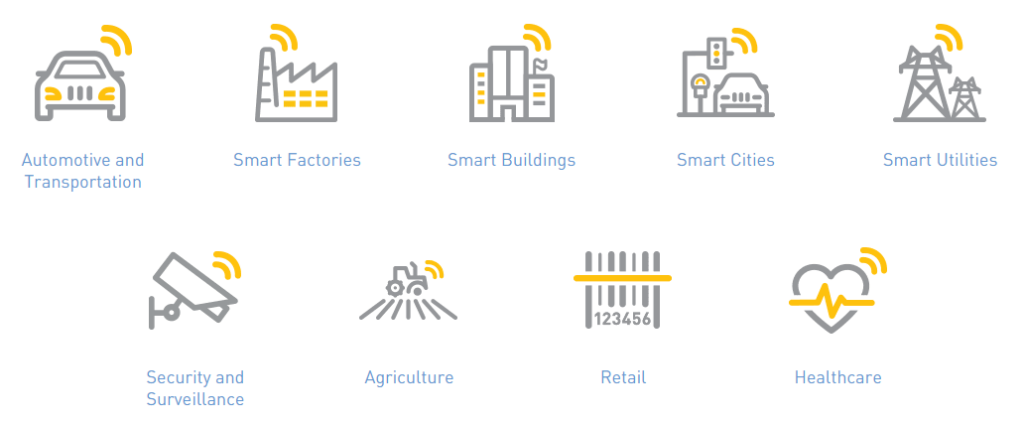
5G IoT Use Cases (Source Telit)
In the next 20 years, the 5G future will look completely different. We will see the large-scale automation of vehicles and utility services like waste management and energy production through smart grids and smart environmental monitoring to cut down greenhouse gases and pollution.
For example, Farmers in rural areas will be able to monitor and track crops, livestock, and machinery more easily through drones and super-dense sensor networks. Home users will be able to fully integrate the work-from-home paradigm and will be capable of optimizing power usage and streaming their favorite entertainment from anywhere.
The 5G IoT Module Market
As per Mckinsey, It’s expected that IoT players to offer three types of 5G modules for B2Buse cases:
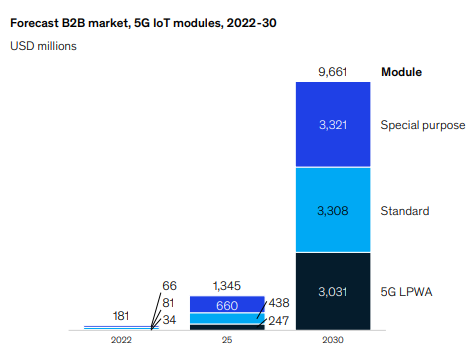
Forecast B2B market, 5G IoT modules, 2022-2030 (Source: McKinsey analysis )
- Standard modules: Used for classic 5G scenarios that require EMBB, such as ultra-HD video streaming.
- Special-purpose modules: Designed for specific use cases that require URLLC, such as autonomous systems and mission-critical control. Their price may be high since they often must be designed for use in extreme temperatures or rugged conditions. Special-purpose modules also require additional R&D and are sold in lower quantities.
- 5G LPWA modules: Used for long-distance communication, such as transmissions from sensors with low data rates. They will have an evolving and strong role in the growth of 5G IoT since they help enable some MMTC applications.
Conclusion
As the IoT evolves, the flexibility of 5G will become even more significant for enterprises. 5G will support critical communications with even more performance requirements. 5G’s ultra-reliability and low latency could help make self-driving cars, smart energy grids, enhanced factory automation, and other advanced applications a reality.
Building on 4G’s support for IoT, Release 15 and 16 of the 3GPP specifications will provide further support for IoT devices with 5G features, including ultra-reliability and low latency.
References
- GSMA, IoT Opportunities, and Benefits for Enterprises and Consumers.
- McKinsey, Opportunities for advanced electronics companies and industrials.
- SIERRA WIRELESS, 5G for IoT.
- Anritsu, 5G-based IoT(5G/IoT).
- U5gig, 5G- IoT use cases.











